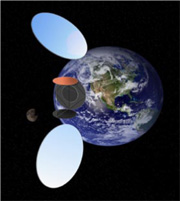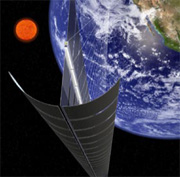Home > Highlighting JAPAN > Highlighting Japan JANUARY 2012 > Harnessing the Power of the Sun in Space
Highlighting JAPAN
COVER STORY: Tomorrow's World
Harnessing the Power of the Sun in Space
The Space Solar Power Systems (SSPS) project is a space-based solar power plant that generates energy by collecting sunlight in geostationary orbit. Researchers in Japan have already moved from the study phase to the technology demonstration phase, aiming for practical use in the 2030s. Toshio Matsubara reports on how Japan is leading the world in this revolutionary technology.

Illustration of the microwave-based SSPS
Credit: COURTESY OF JAXA
Tatsuhito Fujita, associate senior engineer at JAXA, says, "SSPS has numerous advantages over conventional methods of generating electricity. Around 70% of solar energy is lost as it passes through the atmosphere on its way to Earth, but space solar power is a constantly available, stable source of energy, which is unaffected by the time of day, weather or season. Solar energy in space is five to ten times greater per unit area than on the ground. Space solar power is also very environmentally friendly, as the space-based power plant will have zero carbon emissions."
Currently, researchers are examining two different ways of transmitting energy, aiming to achieve commercial SSPS in the 2030s. The two methods under examination are transmission of power by microwaves and transmission by laser beams. The microwave-based space plant comprises two large mirrors 2–3 kilometers in diameter, solar cell panels, microwave transmitters, and transmission antennas. The electricity produced by the solar cells is converted into microwaves and transmitted to a receiving plant on the ground. The receiving plant consists mainly of an array antenna 2 kilometers in diameter known as a rectifying antenna, where the microwaves are once again converted into electricity. Microwaves have the major advantage of being able to pass through clouds on their way to Earth. However, the downside is that energy losses occur during the conversion of electricity into microwaves and the conversion of microwaves back into electricity.

Illustration of laser-based SSPS
Credit: COURTESY OF JAXA
Since both of these methods have advantages and disadvantages, researchers have yet to decide which of the two to choose. The energy density of both laser beams and microwaves is diffused and dispersed when transmitted to Earth, so even if a bird or plane was exposed to them it would not be harmed in any way. With both systems, the receiving facility on the ground is expected to be located on the ocean.
Fujita says, "There are many challenges to overcome, including establishing an efficient low-cost way of transporting the system into space, unmanned robot technology for assembling the system in outer space, technology for controlling beams, reducing energy losses in power conversion, and producing lightweight parts, but the biggest challenge is how to reduce the overall cost of construction."
According to Fujita, if the end point is 10, then the current stage of development is around 2 or 3. Following the ground-based experiments to analyze the transmission of microwaves and laser beams currently underway, JAXA plans to start a geostationary demonstration using Kibo, Japan's experiment module on the International Space Station, and a small satellite in three years from now. This demonstration will include the experimental assembly of a large structure using the International Space Station and higher output transmission experiments and aims to give clear shape to the system concept by around 2020 in preparation for practical use.
Fujita says, "2030 is not so far away. Our roadmap is packed with things that need to be done by then. But I would dearly like to bring this project to fruition because I believe it's a project of enormous significance."
© 2009 Cabinet Office, Government of Japan






